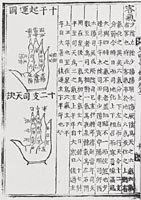KOREAN CLASSICS

Woodblock of the Tripitaka
Koreana. The carving of the woodblocks for the Korean Tripitaka (Buddhist
canon) began in the early eleventh century and was completed
in 1087. The original woodblocks were destroyed during
the thirteenth-century Mongol invasions. The Tripitaka
Koreana that remains today is a later edition, begun
on Kanghwa Island, where the court had taken refuge from
the Mongols. It was completed in 1251. Requiring about
81,200 woodblocks, this edition combines accuracy with
beauty. This woodblock was presented to then- Librarian
of Congress Daniel J. Boorstin by Dr. Hong Joo Moon,
President of the Academy of Korean Studies, in 1986. (Korean
Collection, Asian Division) |
The Library's Korean collection has made up for a relatively
late start and now stands as the largest and most comprehensive
outside Korea. Although the collection is largely contemporary
(this aspect is discussed later), it does contain a number of
valuable pre-nineteenth-century publications in traditional format.
Korea, like Japan and Vietnam, absorbed early cultural influences
from China, including language, and many of its early classics
were written in Chinese. Old Korean books, however, are quite
different from their counterparts in China and Japan. They tend
to be larger and are often printed on tough, durable paper, which
is noted for its beauty and uniform whiteness. Because of the
paper's quality, Korean versions of Chinese classics sometimes
survived the original printings in China. For example, the only
existing version of an important fourteenth-century Chinese map, Sheng-chiao
Kuang-pei t'u (Map of the Vast Reach of China's Moral Teaching),
is a fifteenth-century Korean work containing a copy of the original.
The Library has some 422 titles (2,900 volumes) of rare Korean
books, printed on mulberry paper in Chinese characters, many
of which were obtained in the 1920s. While the majority of the
Korean rare books are in the Asian Division, thirteen titles
are in the Law Library. There are also rare Korean maps in the
Geography and Map Division, including those provided to the Library
by the American geographer Shannon McCune. Unique Korean photographs
may be found in the Prints and Photographs Division.
| 
Yi
Munsun Chip (1241). The collected works of Yi Munsun
(the literary name of Yi Kyu-bo), the great poet, scholar,
and statesman of Korea's Koryo Dynasty (918-1392), were
edited and printed with metal movable type by his son
Yi Ham in about 1241. This was some 215 years before
Gutenberg used a similar process to print his famous
Bibles in Germany. Printed on handmade mulberry paper,
the eight-volume work contains Yi Munsun's essays, poetry,
descriptions of early printing, warnings against shamanism,
and his autobiography. (Korean Collection, Asian
Division)
|
The most important contributor to the Library's classical Korean
book collection was Dr. James S. Gale, a Canadian missionary
who arrived in Korea in 1888 and spent the next forty years there.
A prodigious scholar, Gale translated many of Korea's literary
classics into English and wrote numerous books on Korean history,
literature, and culture. Gale helped the Library procure a number
of Korean classics, including rare books from the estate of the
Korean scholar Kim To-hui. In 1927, the Library received
the major portion of Gale's own library, more than doubling its
Korean holdings.
Korea made a special contribution to the technology of printing
by developing movable cast metal type, beginning in 1241. Although
China first used movable type made of clay, it was in Korea that
printing with movable metal type reached a high point in the
fifteenth century. Korean printing technology spread to China
and Japan, but movable type was not a commercial success and
by the nineteenth century had been almost completely displaced
by the older woodblock printing. This technology in turn soon
gave way to European typography. The Asian Division holds some
fine examples of Korean printing from metal movable type. These
include the collected writings, printed in 1744, of the renowned
sixteenth-century Confucian scholar and statesman Yi I and the
1834 reprint of the works of the "father of Korean literature," Ch'oe
Ch'i-won (857-915 A.D.). Examples of rare woodblock-printed
books include a history of the Koryo Dynasty (Koryð Sa),
printed in 1590, and the law code of the Yi Dynasty (Kyongguk
Taijon), printed in 1630.
| 
Map
of Korean Peninsula. This
map of Korea is one of twelve handcolored maps in the manuscript
atlas, Tae Choson Chido (Great Korean Map). The
atlas, dating to circa 1800, has individual maps of the
provinces of Korea and maps of the world, China, and Japan. (Geography
and Map Division)
|
 |
 |
|
The Tonqui Pogam was
written by the physician Ho Chun at the order of King Sonjo
(1567-1608). Completed in 1611, it combines Chinese and
Korean medical writings on disease and treatment, and covers
topics such as pediatrics, gynecology, acupuncture, surgery,
and general medicine. The most important medical compendium
of Korea's Yi Dynasty, the work was widely read in China
and Japan. This 1754 edition, consisting of twenty-two
volumes, was printed with wood blocks. (Korean Collection,
Asian Division)
|
|